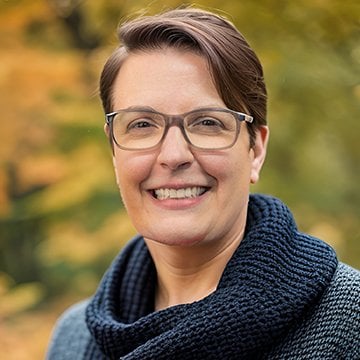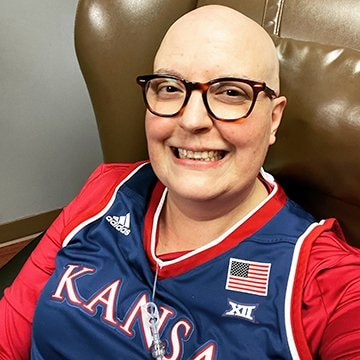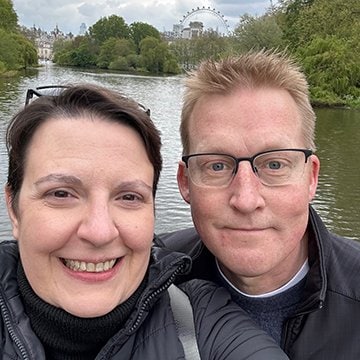From diagnosis to recovery: A first-hand look at breast cancer
Sometimes the hardest story to tell is your own.
Megan Poindexter. Chelly Sumner. Amy Thompson. Over the past year, LMH Health has shared stories of these women who have faced breast cancer. And now it’s time to share mine.
I have an innate respect for the medical profession. My grandmother was a nurse, my daughter is an emergency medicine nurse and I now work for a health system. That’s part of the reason I make sure to get screening tests when they’re recommended. Annual blood work? Done each January. Mammogram? I get them every November, right before Thanksgiving.

Autumn Bishop
Getting a mammogram is an easy process that takes about 30 minutes from start to finish. You fill out some paperwork, go over your personal and family medical history and get the scan. The mammography technologist takes a few images, tells you that the radiologist will review them that day and to expect a letter in the mail if you’re in the clear. When I left the LMH Health Women’s Center on that day in November 2022, I didn’t know it was the day that would change my life.
I received a call early the next week from the Women’s Center. The radiologist saw something on the images that didn’t look quite right.
“When the radiologist reads the images, they’re looking for any changes from what was seen on images from prior mammograms,” said Dr. Jodie Barr, an oncologist with the LMH Health Cancer Center. “If this is a first-time image, they’re looking for grouped calcifications, areas of distortion or an obvious mass.”
A diagnostic mammogram, ultrasound and a biopsy all followed within the next ten days. On December 7, I got a call from Dr. Jennifer Hawasli, a breast surgeon at Lawrence Breast Specialists, with the words I’d been dreading.
Autumn, it’s not the result that we hoped for. I’m sorry to say it, but you’ve got breast cancer.
Plan of attack
How could this be? I was only 45. I didn’t have any symptoms and wasn’t able to feel the lump. According to Dr. Barr, about a third of patients with breast cancer don’t have a palpable mass.
The fact remained that I had cancer and it was time to figure out how to deal with it. I knew that I wanted to get treatment close to home, and I chose to get care at the LMH Health Cancer Center with Dr. Barr. In order to determine how to treat my cancer, she first had to learn about its genetic makeup.
The Centers for Disease Control and Prevention says to think of cancer like a house. There are three kinds of locks, or receptors, on the front door. One is for estrogen (ER), one is for progesterone (PR) and the third is a protein called human epidermal growth factor (HER2). If the cells have any of these locks, there are a few keys to treatment, such as hormone therapy or other drugs that can be used to destroy the cancer.

Chemotherapy - March 2023
“When the results came back, it showed that your cancer was triple negative, meaning that the cancer cells didn’t express estrogen, progesterone or HER2. Triple negative cancers are more aggressive, meaning they tend to grow and spread more quickly than other types of breast cancer,” Dr. Barr explained.
According to the American Cancer Society, triple negative breast cancer accounts for 10-15% of all breast cancers. It tends to be more common in women younger than age 40, who are Black or who have a BRCA1 gene mutation. And since it doesn’t contain any of those locks, it means that chemotherapy is the option.
The plan of attack was 12 rounds of neoadjuvant chemotherapy, or chemo that takes place prior to surgery. Dr. Barr explained that this type of chemo is used with three goals in mind:
- Improve the success of breast conservation surgery by shrinking the tumor
- Get prognostic information based on the body’s response to chemotherapy
- Decrease the chance of finding additional lymph nodes that contain cancer, as the goal is not to find cancer in the sentinel lymph node biopsied during surgery
I’d have an infusion of two drugs each week for 12 weeks with an extra drug – a monoclonal antibody - added to the mix every three weeks. Carboplatin, paclitaxel and pembrolizumab (Keytruda) became my partners in crime for three months, working diligently to shrink the number of hairs on my head and the tumor growing inside my body. After I’d finished those drugs, we’d move to another cocktail, including Adriamycin and cyclophosphamide, also known as AC or the “red devil,” due to the very red color of the medication.
“The chemotherapy regimen is different for everyone,” Dr. Barr said. “New data shows that we can get patients with triple negative cancer through the whole regimen by starting with carboplatin and taxol before we move to AC. If the tumors are smaller and we don’t use carboplatin, then a lot of the time we start with AC first. It’s very patient-dependent.”
Getting rid of the problem
Once I’d completed six months of grueling chemo, it was time for a break and another MRI to see if my tumor was succumbing to the medicine that had been coursing through my veins. Fortunately for me, the tumor had gotten smaller and I was a candidate for surgery.
On June 21, I was off to the surgery center at the LMH Health West Campus. It was time to get rid of those OEM parts of my body, you know the ones that were actively trying to kill me? It was time for a double mastectomy.
Surgery was uneventful, or as least as uneventful as it can be when you’re undergoing something that major. I was told that I was a hoot in the recovery room, which apparently involved asking all kinds of questions about medications I was on and wondering what kind of pudding was available. But I went home the same afternoon and began the road to recovery.
I’ve been through reconstructive surgery and additional Keytruda infusions but on January 12, 2024, the day finally came. I had my final infusion and got to do the one thing that so many living with cancer look forward to. I rang the bell.
Ring this bell
Three times well
Its toll to clearly say,
My treatment’s done
The course is run
And I am on my way!

Autumn and Brian Bishop after the end of treatment
With those words from Irve Le Moyne and the clang of the bell on the wall, my course of treatment was over. I made it through the biggest fight of my life. I made it through days where I was so sick that I didn’t want to move an inch and when I was so tired that I just couldn’t keep my eyes open. I made it through panic inducing moments like watching hair come out of my head in clumps and days where food tasted so awful that I didn’t want to eat. But I did it. I made it.
It wasn’t an easy year. I experienced the loss of beloved family members, grieved changing friendships and coped with ways that cancer will forever define my life. But one thing I didn’t do is give up.
I hope that you never experience the uncertainty and the fear that come with a cancer diagnosis. If it does happen to you or someone you love, turn to the team at LMH Health. From the mammogram on that November day through treatment, surgery and now survivorship, I got world-class care, right here in my own backyard.
My entire care team - Dr. Hawasli, Dr. Barr and Dr. Scarlett Aldrich, the amazing imaging techs, oncology nurses and doctors, volunteers and everyone I’ve interacted with along the way – they saved my life. And if you find yourself in the same position I was, they’ll work day and night to save yours, too.
Can’t afford a mammogram? Help is available.
At LMH Health, our goal is to ensure that everyone age 40 and older has affordable to regular screening mammograms and diagnostic mammograms when necessary. This includes providing financial assistance for patients who are uninsured or underinsured. To learn how to receive a voucher to cover the cost of your mammogram, call 785-505-5782.